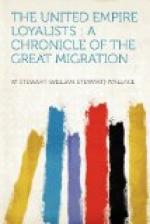This kind of warfare tends to perpetuate itself indefinitely. In 1780 the Loyalists and Indians returned to the attack. In May Sir John Johnson with his ’Royal Greens’ made a descent into the Mohawk valley, fell upon his ‘rebellious birthplace,’ and carried off rich booty and many prisoners. In the early autumn, with a force composed of his own regiment, two hundred of Butler’s Rangers, and some regulars and Indians, he crossed over to the Schoharie valley, devastated it, and then returned to the Mohawk valley, where he completed the work of the previous spring. All attempts to crush him failed. At the battle of Fox’s Mills he escaped defeat or capture by the American forces under General Van Rensselaer largely on account of the dense smoke with which the air was filled from the burning of barns and villages.
How far the Loyalists under Johnson and Butler were open to the charges of inhumanity and barbarism so often levelled against them, is difficult to determine. The charges are based almost wholly on unsubstantial tradition. The greater part of the excesses complained of, it is safe to say, were perpetrated by the Indians; and Sir John Johnson and Colonel Butler can no more be blamed for the excesses of the Indians at Cherry Valley than Montcalm can be blamed for their excesses at Fort William Henry. It was unfortunate that the military opinion of that day regarded the use of savages as necessary, and no one deplored this use more than men like Haldimand and Carleton; but Washington and the Continental Congress were as ready to receive the aid of the Indians as were the British. The difficulty of the Americans was that most of the Indians were on the other side.
That there were, however, atrocities committed by the Loyalists cannot be doubted. Sir John Johnson himself told the revolutionists that ’their Tory neighbours, and not himself, were blameable for those acts.’ There are well-authenticated cases of atrocities committed by Alexander Macdonell: in 1781 he ordered his men to shoot down a prisoner taken near Johnstown, and when the men bungled their task, Macdonell cut the prisoner down with his broadsword. When Colonel Butler returned from Cherry Valley, Sir Frederick Haldimand refused to see him, and wrote to him that ’such indiscriminate vengeance taken even upon the treacherous and cruel enemy they are engaged against is useless and disreputable to themselves, as it is contrary to the disposition and maxims of their King whose cause they are fighting.’
But rumour exaggerated whatever atrocities there were. For many years the Americans believed that the Tories had lifted scalps like the Indians; and later, when the Americans captured York in 1813, they found what they regarded as a signal proof of this barbarous practice among the Loyalists, in the speaker’s wig, which was hanging beside the chair in the legislative chamber! There may have been members of Butler’s Rangers who borrowed from the Indians this hideous




